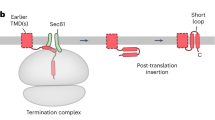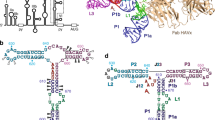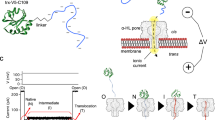Abstract
A UNIVERSAL feature of integral transmembrane proteins is a hydrophobic peptide segment that spans the lipid bilayer. These hydrophobic domains are important for terminating the trans-location of the polypeptide chain across the membrane of the endoplasmic reticulum (a process termed stop transfer) and for integrating the protein into the bilayer1–5. But a role for extracytoplasmic sequences in stop transfer and transmembrane integration has not previously been shown. Recently, a sequence which directs an unusual mode of stop transfer has been identified in the prion protein. This brain glycoprotein exists in two isoforms6–8, which are identical both in primary amino-acid sequence and in containing phosphatidylinositol glycolipid linkages at their C termini, which can be cleaved by a phophatidylinositol-specific phospholipase C9. But only one of the isoforms (PrPc) is released from cells on treatment with this phospholipase10, indicating that the two isoforms have either different subcellular locations or transmembrane orientations. Consistent with this is the observation of two different topological forms in cell-free systems11,12. An unusual topogenic sequence in the prion protein seems to direct these alternative topologies (manuscript in preparation). In the wheat-germ translation system, this sequence directs nascent chains to a transmembrane orientation; by contrast, in the rabbit reticulocyte lysate system, this sequence fails to cause stop transfer of most nascent chains. We have now investigated determinants in this unusual topogenic sequence that direct transmembrane topology, and have demonstrated that (1) a lumenally disposed charged domain is required for stop transfer at the adjacent hydrophobic domain, (2) a precise spatial relationship between these domains is essential for efficient stop transfer, and (3) codons encompassing this hydrophilic extracytoplasmic domain confer transmembrane topology to a heterologous protein when engineered adjacent to the codons for a normally translocated hydrophobic domain. These results identify an unexpected functional domain for stop transfer in the prion protein and have implications for the mechanism of membrane protein biogenesis.
This is a preview of subscription content, access via your institution
Access options
Subscribe to this journal
Receive 51 print issues and online access
$199.00 per year
only $3.90 per issue
Buy this article
- Purchase on Springer Link
- Instant access to full article PDF
Prices may be subject to local taxes which are calculated during checkout
Similar content being viewed by others
References
Rose, J. K. & Bergmann, J. E. Cell 30, 753–762 (1982).
Gething, M. J. & Sambrook, J. Nature 300, 598–603 (1982).
Cutler, D. F. et al. J. Cell Biol. 102, 902–910 (1986).
Doyle, C. et al. J. Cell Biol. 103, 1193–1204 (1986).
Adams, G. A. & Rose, J. K. Cell 41, 1007–1015 (1985).
Oesch, B. et al. Cell 40, 735–746 (1985).
Meyer, R. K. et al. Proc. natn. Acad. Sci. U.S.A. 83, 2310–2314 (1986).
Prusiner, S. B. New Engl. J. Med. 317, 1571–1581 (1987).
Stahl, N. et al. Cell 51, 229–240 (1987).
Stahl, N. et al. FASEB J. 2, A989, (1988).
Hay, B. et al. Biochemistry 26, 8110–8115 (1987).
Hay, B. et al. Molec. cell. Biol. 7, 914–920 (1987).
Blobel, G. Proc. natn. Acad. Sci. U.S.A. 77, 1496–1500 (1980).
Perara, E. & Lingappa, V. R. in Protein Transfer and Organelle Biogenesis (eds Das, R.C. & Robbins, P.) 3–47 (Academic, San Diego, 1989).
Boeke, J. D. & Model, P. Proc. natn. Acad. Sci. U.S.A. 79, 5200–5204 (1982).
Yost, C. S. et al. Cell 34, 759–766 (1983).
Rothman, R. E. et al. J. biol. Chem. 263, 10470–10480 (1988).
Lingappa, V. R. et al. Proc. natn. Acad. Sci. U.S.A. 81, 456–460 (1984).
Perara, E. & Lingappa, V. R. J. Cell Biol. 101, 2292–2301 (1985).
Eisenberg, D. A. Rev. Biochem. 53, 595–623 (1984).
Davis, N. G. & Model, P. Cell 41, 607–614 (1985).
Zerial, M. et al. Cell 48, 147–155 (1987).
Widemann, M. et al. Nature 328, 830–833 (1987).
Gilmore, R. & Blobel, G. Cell 42, 497–505 (1985).
Sivasubramanian, N. & Nayak, D. P. Proc. natn. Acad. Sci. U.S.A. 84, 1–5 (1987).
Davis, G. L. & Hunter, E. J. Cell Biol. 105, 1191–1203 (1987).
Szczesna, S. E. et al. Proc. natn. Acad. Sci. U.S.A. 85, 738–742 (1988).
Lipp, J. & Dobberstein, B. J. Cell Biol. 106, 1813–1820 (1988).
Siegel, V. & Walter, P. Cell 52, 39–49 (1988).
Lingappa, V. R. J. clin Invest. 83, 739–751 (1989).
Carlson, G. E. et al. Cell 46, 503–511 (1986).
Hsiao, K. et al. Nature 338, 342–345 (1989).
Westaway, D. et al. Cell 51, 651–662 (1987).
Melton, D. et al. Nucleic Acids Res. 12, 7035–7056 (1984).
Basler, K. et al. Cell 46, 417–428 (1986).
Hansen, W. et al. Cell 45, 397–406 (1986).
Author information
Authors and Affiliations
Rights and permissions
About this article
Cite this article
Yost, C., Lopez, C., Prusiner, S. et al. Non-hydrophobic extracytoplasmic determinant of stop transfer in the prion protein. Nature 343, 669–672 (1990). https://doi.org/10.1038/343669a0
Received:
Accepted:
Issue Date:
DOI: https://doi.org/10.1038/343669a0
This article is cited by
-
Interactions of Prion Protein With Intracellular Proteins: So Many Partners and no Consequences?
Cellular and Molecular Neurobiology (2010)
-
Neonatal lethality in transgenic mice expressing prion protein with a deletion of residues 105–125
The EMBO Journal (2007)
-
Understanding the biogenesis of polytopic integral membrane proteins
Journal of Membrane Biology (2003)
-
Prions: health scare and biological challenge
Nature Reviews Molecular Cell Biology (2001)
Comments
By submitting a comment you agree to abide by our Terms and Community Guidelines. If you find something abusive or that does not comply with our terms or guidelines please flag it as inappropriate.



